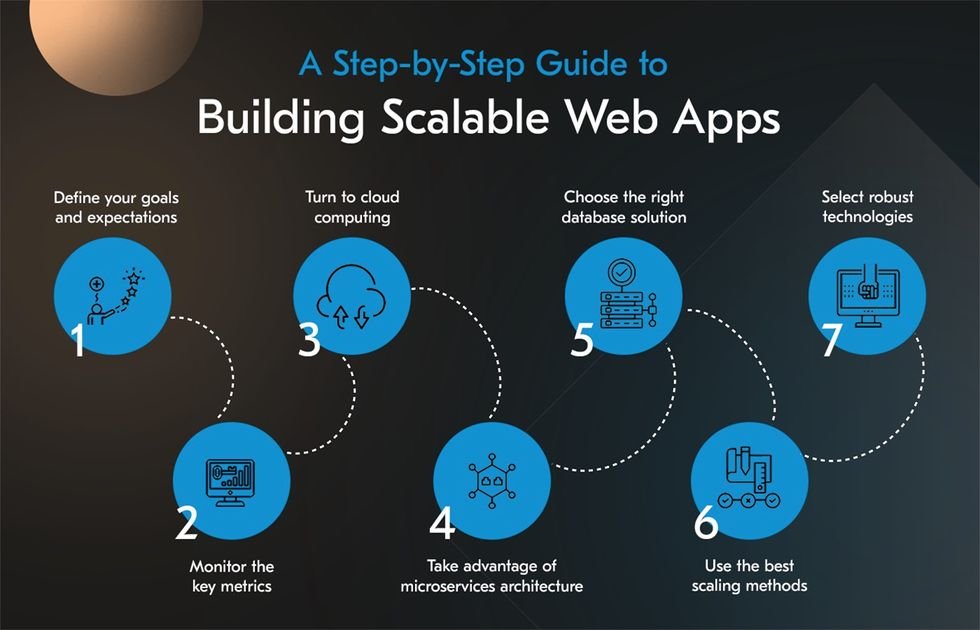Building scalable applications is crucial for accommodating growth and ensuring consistent performance as user demands increase. Scalability involves designing and implementing systems that can handle a growing amount of work or traffic efficiently. Here’s a guide to key strategies and best practices for building scalable applications.

Understand Scalability
Scalability refers to the capability of an application to handle increasing loads without compromising performance. It involves both horizontal and vertical scaling.
Horizontal vs. Vertical Scaling
- Horizontal Scaling: Adding more machines or instances to distribute the load. It involves scaling out.
- Vertical Scaling: Increasing the resources of a single machine, such as CPU or memory. It involves scaling up.
Design for Scalability
Designing an application with scalability in mind from the start helps avoid bottlenecks and ensures that the system can grow with user demands.
Key Principles
- Modular Architecture: Break the application into smaller, independent modules or services. This approach allows for better management and scaling of individual components.
- Loose Coupling: Ensure that different components or services of the application are loosely coupled. This enables independent scaling and reduces the impact of changes in one component on others.
- Microservices: Use a microservices architecture to divide the application into smaller, self-contained services that can be developed, deployed, and scaled independently.
Optimize for Performance
Performance optimization is essential for ensuring that the application remains responsive and efficient under increasing load.
Key Techniques
- Caching: Implement caching strategies to store frequently accessed data in memory. This reduces the load on the database and improves response times.
- Load Balancing: Use load balancers to distribute incoming traffic across multiple servers or instances. This helps prevent any single server from becoming overwhelmed.
- Database Optimization: Optimize database queries and use indexing to speed up data retrieval. Consider using a distributed database system for handling large amounts of data.
Implement Effective Data Management
Data management is critical for scalable applications, especially when dealing with large volumes of data.
Key Strategies
- Sharding: Divide the database into smaller, manageable pieces called shards. Each shard can be stored on a different server, improving performance and scalability.
- Data Partitioning: Partition data based on certain criteria, such as date ranges or user IDs. This helps in managing and querying large datasets more efficiently.
- Asynchronous Processing: Use asynchronous processing for tasks that do not require immediate results. This prevents blocking operations and improves overall performance.
Leverage Cloud Services
Cloud services offer scalable infrastructure and resources that can be adjusted based on demand. They provide flexibility and reduce the need for managing physical hardware.
Key Services
- Elastic Compute: Use cloud-based virtual machines or container services that can scale up or down based on demand.
- Managed Databases: Utilize managed database services that automatically handle scaling, backups, and maintenance.
- Serverless Computing: Adopt serverless architectures to run code in response to events without managing servers. This allows for automatic scaling based on usage.
Monitor and Analyze Performance
Monitoring and analyzing performance helps identify bottlenecks and areas for improvement.
Key Tools
- Application Performance Monitoring (APM): Tools like New Relic and Dynatrace provide insights into application performance and detect issues in real time.
- Logging: Implement logging to track application events and errors. Analyze logs to diagnose problems and understand usage patterns.
- Analytics: Use analytics tools to gather data on user behavior and application performance. This information can guide optimization efforts.
Ensure High Availability
High availability ensures that the application remains accessible and operational even during failures or maintenance.
Key Strategies
- Redundancy: Deploy redundant components and systems to prevent single points of failure. This includes using multiple servers, databases, and network connections.
- Failover: Implement failover mechanisms to automatically switch to backup systems in case of a failure.
- Disaster Recovery: Develop a disaster recovery plan to restore the application and data in case of major outages or disasters.
Plan for Future Growth
Anticipating future growth helps in designing an application that can scale seamlessly as demand increases.
Key Considerations
- Scalable Architecture: Choose an architecture that supports easy scaling and modification as requirements evolve.
- Performance Testing: Regularly test the application under simulated high loads to identify potential issues and plan for scaling.
- Capacity Planning: Estimate future resource needs and plan infrastructure upgrades accordingly.
Conclusion
Building scalable applications involves understanding scalability concepts, designing with growth in mind, optimizing performance, and leveraging cloud services. By implementing effective data management, monitoring performance, ensuring high availability, and planning for future growth, you can create applications that handle increasing loads and provide a consistent user experience. Scalability is a crucial aspect of modern application development and contributes to the long-term success and reliability of your software.
